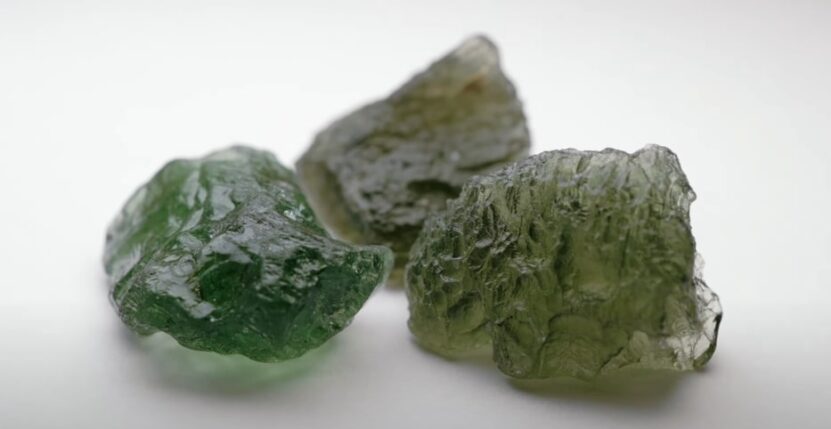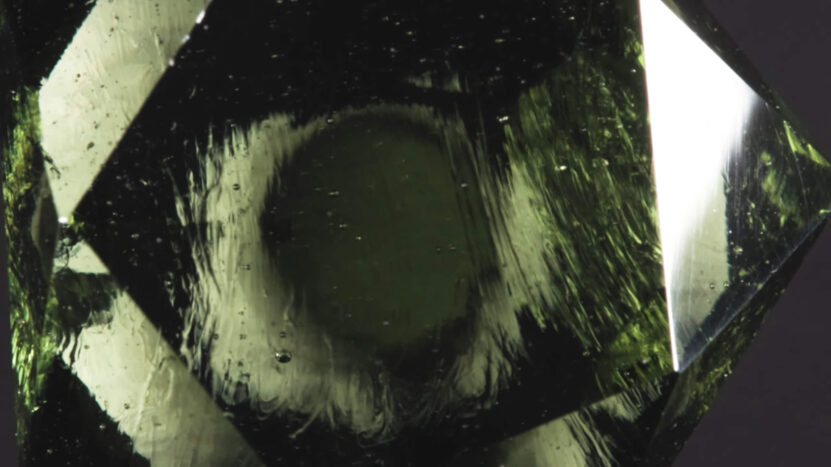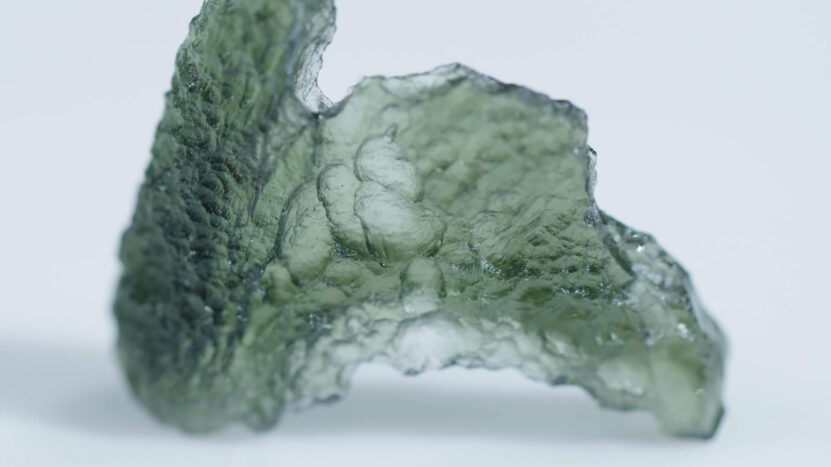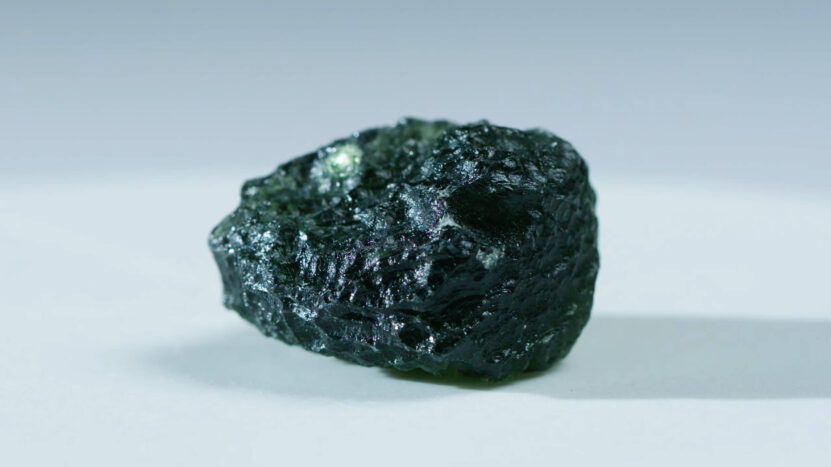Moldavite is a pretty cool stone that has gained a lot of attention lately, mainly due to its unique color and spiritual vibes. However, with its rise in popularity, spotting a fake has become harder.
If you’re looking to buy this gemstone for yourself, it’s good to know how to tell what’s real and what’s not. There are some key things you can check to make sure you’re not being sold an imitation stone.
Let’s go over what you need to look out for to get the real deal.
Main Features

Moldavite is a unique natural glass, created by a meteorite impact that occurred around 15 million years ago in what is now the Czech Republic.
Unlike other gemstones like diamonds or rubies, moldavite is classified as a tektite, a natural form of glass that forms from extreme heat and pressure.
This gives it a distinctive origin, unlike traditional Earth-formed stones like malachite or quartz.
Key features include:
- Color: Typically ranges from olive green to deep forest green, sometimes with brown streaks. The color can vary slightly depending on where it is sourced. Moldavite from Southern Bohemia tends to have a bottle green hue, while stones from Southern Moravia may have a brownish tint.
- Surface Texture: Real stone has a rough, pitted surface due to the intense formation process. This texture is a key identifier, distinguishing it from smoother stones like diamonds or malachite.
- Inclusions and Bubbles: One of the most distinctive features is the presence of internal gas bubbles and swirl-like inclusions. These features were trapped inside the stone during its rapid cooling after the meteorite impact.
Comparison with Other Jewelry
| Moldavite (Tektite) | Malachite (Mineral) | Diamond (Gemstone) | |
|---|---|---|---|
| Origin | Meteorite impact (Extraterrestrial) | Found in copper deposits | Formed deep within Earth |
| Color | Olive to deep green | Bright green with blue bands | Colorless or various hues |
| Surface | Rough, pitted | Smooth or banded | Smooth, highly polished |
| Transparency | Transparent to translucent | Opaque | Transparent |
| Hardness | 5.5 on Mohs scale | 3.5 to 4 on Mohs scale | 10 on Mohs scale |
| Rarity | Rare, only found in Europe | More common | Very rare in certain colors |
How to Tell Real from Fake?
Due to the increasing demand, the market is flooded with fake pieces. Knowing how to spot the real thing is critical for collectors and enthusiasts alike. Here’s a breakdown of the key steps to identify genuine moldavite:
1. Start with the Color

Real gemstone is known for its deep olive to forest green hue. The color can sometimes have brown streaks, depending on where it was found. In contrast, fake moldavite often comes in unnaturally bright or neon green shades that look uniform and lack depth.
Authentic moldavite typically has color variations, even within the same piece.
2. Check for Surface Texture and Roughness
It has a rough, pitted surface that forms naturally during the meteorite impact that created it. These features are difficult to replicate. Fake moldavite, made from manufactured glass, usually has a smoother surface.
Look for natural etchings, grooves, and sculptural patterns that are unique to moldavite. Authentic pieces will not have identical shapes or patterns.
3. Look for Inclusions and Bubbles

Real moldavite contains gas bubbles and inclusions, trapped during its rapid formation. These bubbles are usually unevenly distributed and can vary in size.
Fake moldavite may have bubbles, but they often appear uniform and can be found on the surface. Real moldavite inclusions often consist of tiny glass threads (lechatelierite).
4. Weigh the Stone for Accuracy
Moldavite is relatively light, with a density ranging between 2.3 and 2.5 g/cm³. Fake moldavite, usually made from green glass, is often denser and heavier. If a piece feels unusually heavy or light, it’s worth examining further.
Additional Tips
When purchasing moldavite, a few extra considerations can help you ensure authenticity. Fake moldavite has become widespread, so taking these additional precautions can save you from buying a counterfeit piece.
Pay Attention to the Price
Genuine is rare and expensive. The price per gram can range from several hundred to thousands of dollars, depending on the quality and size. If you come across a deal that seems too good to be true, it likely is.
Fake moldavite, usually made from green glass, is sold at much lower prices to lure in unsuspecting buyers. If you see large, well-formed pieces being sold cheaply, it’s a red flag.
Verify the Seller’s Credibility
It’s crucial to buy moldavite only from trusted and reputable sellers. Ask for detailed information about the stone’s origin, and avoid pieces marketed as “African” or “lab-grown” moldavite, which are simply green glass imitations.
Sellers who specialize in moldavite and can provide proof of origin are more likely to be trustworthy. Some fake moldavite comes with certificates of authenticity, but these can also be fabricated.
Always research the seller’s reputation before making a purchase.
Know Its Origin

As we already mentioned. true moldavite comes only from specific regions in the Czech Republic, primarily in South Bohemia and Moravia. If a seller claims the stone is from another region or country, it’s likely a fake.
Authentic moldavite will often be accompanied by information about where it was mined. Be cautious of any vague or misleading details about its origin.
FAQs
How much does moldavite cost?
The price of moldavite can vary depending on size and quality, ranging from around $15 to $25 per gram for average pieces. Larger or higher-quality pieces can cost several hundred or even thousands of dollars per gram.
Can moldavite change color over time?
Moldavite’s color remains stable over time. However, exposure to harsh chemicals or extreme temperatures could potentially affect its surface appearance. Keeping the stone clean and stored properly will help maintain its natural color.
Is moldavite radioactive?welry
Moldavite is not radioactive. Despite its extraterrestrial origins, it is completely safe to handle and wear, making it suitable for jewelry and spiritual practices.
Can moldavite be used in meditation?
Yes, many people use moldavite in meditation practices. It’s believed to enhance spiritual growth and deepen meditation experiences by connecting with higher realms or energies.
Last Words
In conclusion, identifying real moldavite requires careful attention to several factors, including its color, texture, inclusions, and weight. Authentic moldavite is unique due to its formation from a meteorite impact, making it rare and highly sought after.
Being aware of its physical features and purchasing only from reputable sellers will help ensure you’re getting a genuine piece.
